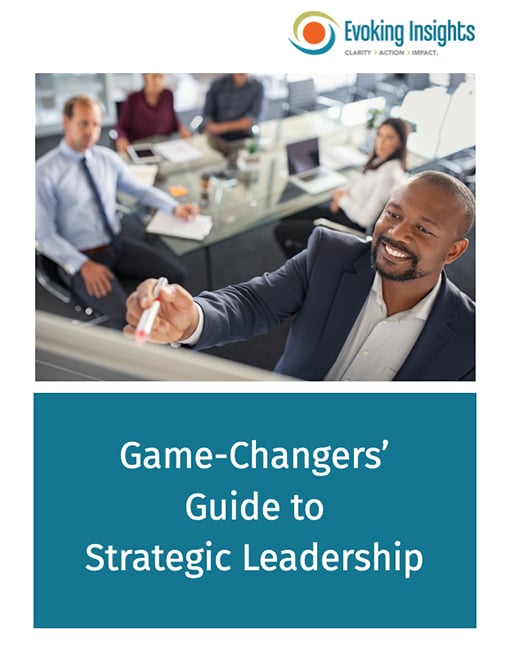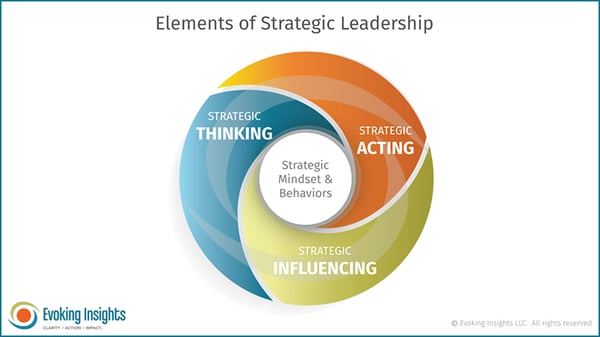Game-Changers' Guide to Strategic Leadership
Strategic Leadership: A Calling
You have a fire in your belly. You want to impact change in the world. What each of us is called to impact varies:
- “To help millions of people breathe better”
- “To improve health by unlocking the power of the genome”
- “To organize the world’s information, making it universally accessible and useful”
- “Empowering people to take control of diabetes”
- “Transforming the business world, one leader at a time”
What we have in common is a desire to shape and create a future that does not yet exist. To transform the world, through business, for good. We feel called to be the architects of these futures.
We are called to be Strategic Leaders.
Transformers.
Trailblazers and game‑changers.
You may or may not identify as one yet. And that’s OK. Because becoming a strategic leader is a journey. A journey of continual transformation — without a particular endpoint. No matter where you are in that journey, there is always opportunity for greater impact.
My purpose is to amplify our strategic impact. Because I believe corporations can be a force of change for good. And whether they are or aren’t is ultimately determined by, us, the leaders — in the decisions we make and the cultures we create.
My journey has been a transformation from a strategic thinker (by nature) to a strategic leader. To the bold identity of transformer and game‑changer. I am still aspiring to that last label.
Some days I hold myself to the standard of inspirational game‑changers:
- Ruth Bader Ginsburg
- Herb Kelleher
- Martin Luther King
Other days, I remember a game‑changer is any individual, or more likely group of individuals, who conceive and create a new way of seeing or doing something that transforms lives for the better. That transformation may be on the scale of one life or millions. The scale isn’t the defining element. It is only the possibility.
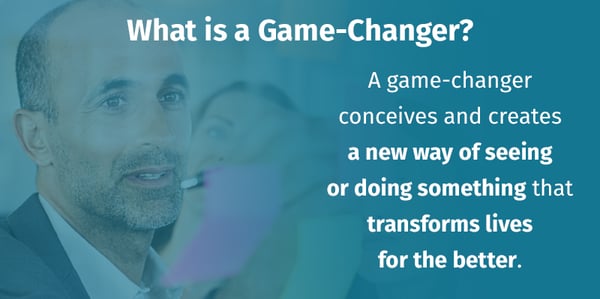
Painting a Picture of Strategic Leadership
So what exactly does it mean to be a strategic leader? And how is it different from operational or results leadership? While the two are quite inter‑related, strategic leaders must make decisions that position the business for the future.
A strategic leader’s fundamental purpose is to evolve the organization to sustainably create long‑term value. We must align short‑term actions with long‑term direction.
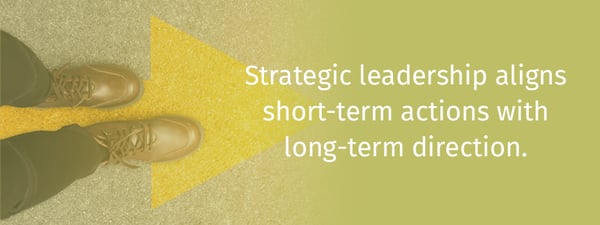
Strategic Leadership Is NOT Short‑Term
Leaders challenged to ‘be more strategic’ tend to be narrowly focused on delivering short term targets, often with a continuous improvement mindset. What is missing is a sense of direction — a vision for the future and context to believe that the organization is not just delivering any results, but the ones that matter most.
Sometimes when people hear ‘vision’, they picture visionaries on a grand scale. Visionaries like
- Steve Jobs
- Elon Musk
- Marie Curie
It can be intimidating. But to be visionary can be as simple as envisioning a future. How imaginative, creative or original that future state vision is not the standard — only the possibility.
Strategic Leadership is NOT Reserved for Grand Visionaries
Strategic leadership is not reserved for grand visionaries, larger than life personalities, or the C‑suite. There is no job title of “strategic leader” per se. Any leader in an organization can engage in strategic leadership at any time — provided you practice the mindset, behaviors, and principles of strategic leadership in the day‑to‑day.
Strategic Leadership is Being Future Focused in the Present Moment
While I often hear people refer to day‑to‑day operational leadership, day‑to‑day strategic leadership is a less common reference. Because let’s face it, we can’t live in the future. We can only act in the present moment. As a result, the incorporation of strategic leadership can be limited to the moments we spend time thinking about the future. Crafting that vision and creating the strategic plan that will take us there.
But strategic leadership is so much more than time spent envisioning the future. It is about:
- Direction‑setting choices, trade‑offs, and decision‑making for long‑term impact
- Influence and alignment to translate strategic intent into desired outcomes
- Finding clarity and focus no matter how complex and ambiguous conditions may be
- Learning and adapting to futures undeniably different than what we anticipated
All of that occurs in the day‑to‑day of strategic leadership. Sounds complex. And it can be. But it also can be deeply rewarding.
Strategic mindsets, behaviors, and skill sets can be honed over time. I think of strategic leadership as becoming an artist, or writer, or any type of creator. There are tools and techniques that can get you started. The craft emerges through dedicated practice.
What Makes a Strategic Leader
Strategic Leadership Mindset
Let’s start with the basics. Where do you focus your attention each day? The mindset of a strategic leader is distinct. It is the perspective from which you approach opportunities, challenges, decisions, or even meetings. It can be present and practiced on a daily basis.
I can’t start a meeting without knowing its purpose and desired outcome – basically, WHAT are we trying to achieve and WHY? And I struggle to make a decision without putting it into a broader context.
For example: Ballot measures drive me crazy for this reason. Do you want to fund education, they ask? Sure I do, but relative to what else? There is no context to understand the necessary funding trade‑off. Is my vote really for a dollar more on education and a dollar less on infrastructure?
Strategic leaders have a broad view of the world in which they operate. They are constantly interpreting the landscape and indicators they see, using the insight they gain to actively shape the future. While strategic leaders must embrace ambiguity, uncertainty, and adaptability, operational leaders are rewarded for eliminating ambiguity and delivering predictable, repeatable results through a “well‑oiled” machine.
Both perspectives are needed. And building the capacity to flex easily between the two to meet the needs of the situation is invaluable.
Think about it: Do you have a default mode?
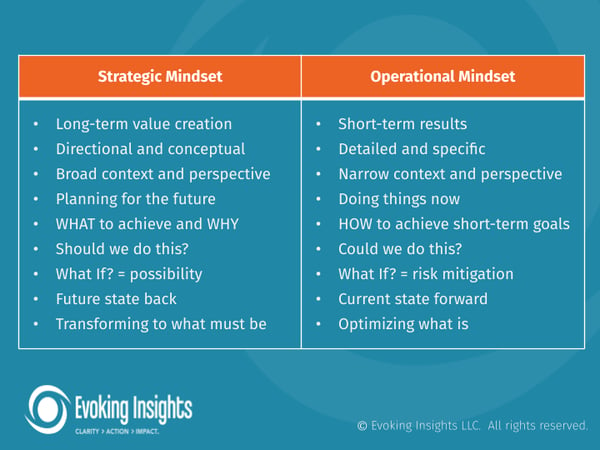
Strategic Leadership Behaviors
Strategic leaders regularly practice key behaviors that enable them to think strategically, set direction, and drive organizational change. As with strategy, there are many perspectives and articles that outline different behaviors. However, a practical starting point is the set of six strategic skills identified through research of over 20,000 executives at the Wharton School.
Six Skills of Strategic Leaders
- Anticipate – scan the environment for signals of change
- Challenge – question the status quo and existing paradigms and assumptions
- Interpret – see connections and patterns and create new insights
- Decide – evaluate options and consider trade‑offs, balancing short and long‑term
- Align ‑ achieve buy‑in among stakeholders who have disparate views and agendas
- Learn – adapt based on disconfirming evidence, even after a decision has been made
This article describes the six skills in detail, including action steps and practices to strengthen these foundational skills. I would also add “elevate” to this list — widen your perspective. The quintessential “see the forest through the trees.” Strategic leaders are known for holding a broad perspective on the world in which they operate.
These behaviors group into three higher‑level competencies of strategic leaders. Defined by the Center for Creative Leadership and consistent with my own experience, the three competencies are:
- Strategic Thinking (anticipate, challenge, interpret, learn)
- Strategic Acting (decide)
- Strategic Influencing (align)
Strategic Leadership Competency 1: Strategic Thinking
Strategic thinking is time spent to gain strategic clarity and insight. It involves both breadth and depth of perspective.
Strategic thinking is:
- Forward‑looking
- Diving deep into the complex environment in which you operate, internally and externally
- Monitoring, analyzing, anticipating, and interpreting an ever‑changing environment, and deciding what matters most
- Discerning the signals from the noise within all the data, and making new connections across seemingly unconnected dots
Strategic thinkers practice identifying
- connections
- patterns
- key issues or opportunities
They do this all with the purpose of creating competitive advantage and positioning the organization for an envisioned future. A future that you may even shape and create in the market landscape.
The deeper the thinking, the more robust the strategy.
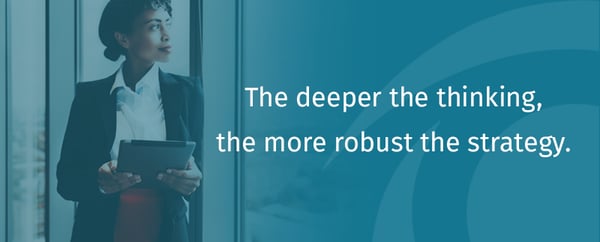
Strategic Leadership Competency 2: Strategic Acting
A leader said to me once, if the strategy isn’t clear just track the key decisions of the past year.
Good strategic leadership results in decisive action that is consistent with the strategic direction and intent of the organization. The tension between daily tasks, quarterly results, and success in the long‑term is actively managed in daily decisions and actions.
Strategy is the underlying logic that guides daily focus and priorities. It should inform what you say NO to, so you can say hell yes to something else— and do it better than anyone in the industry. Yet strategy is more than any one decision.
Strategy is an integrated set of choices and trade‑offs that creates something unique and distinct.
An effective strategic leader understands the organization is interdependent and interconnected; that actions and decisions in one part of the organization have broader impact across the organization. And integrated choices, when done well, become difficult to replicate.
Let’s look at IKEA, for example:
Realized strategy lies in the tough decisions made – despite all the ambiguity, complexity and uncertainty. The consistency of action on those decisions will be determined in the day‑to‑day. The quality of those strategic decisions will reveal over time.
Strategic Leadership Competency 3: Strategic Influencing
Where there is strategy, there is change. And where there is change, there is resistance to that change.
As strategic leaders, we not only need to envision change. We need to bring others along to it. That’s strategic influence.
When considering strategic influencing, I often ask:
- Who in the organization do I need to influence?
- Around what point of alignment am I seeking?
For the “who” of influencing we can simplify it to an organizational position in relation to us:
- Up (executives / BOD)
- Across (peers)
- Down (directs)
There are different dynamics for each. And as a result, our effectiveness may vary. It is often easy to rank these in terms of ease or difficulty in your ability to influence.
Many leaders that I work with effectively drive change down into their organizations once a decision has been made. So, they are surprised when they aren’t as effective in influencing strategic decisions before they are made. Strategic influencing is critical to driving alignment both as the direction is being set and as it is implemented. Because it is never as linear and clear as the strategic plan might suggest. Especially in larger, matrix organizations where competing priorities are part of daily life.
The Complication of Strategic Leadership
Sound doable? We’ve covered the foundational elements on how to BE a strategic leader, day‑in and day‑out. Not just in the moments when you are crafting strategy. Our role is ongoing. We are constantly transforming our organization for long‑term sustainability, persistent in the face of setbacks, and adaptive to environmental shifts.
So, why don’t we have more strategic leaders? Why are less than 10% of leaders demonstrating these mindset, behaviors, and competencies?
The demand for strategic leadership rises with an ever‑increasing degree of change and disruption in our environments. Yet according to PwC conducted research, there has been no meaningful increase in strategic leaders in over a decade.
We have the directions and ingredients. Like following a recipe to bake cookies. Why can’t we just apply these strategic behaviors, mindsets, and competencies and go on our merry way to strategic leadership?
The Experience of Strategic Leadership
Much like strategy, there can be a great divide between our grandiose visions and the stark reality of the day to day. Howard Shultz describes how he experienced that reality after closing every Starbucks store for a day-long retraining:
- “It cost us millions of dollars”
- “I came under tremendous criticism”
- “Competition smelled blood and went after us”
Daunting. The courage of conviction needed to throw yourself into those shark‑infested waters. It feels like we didn’t get the memo on that part of strategic leadership. Our desired impact comes with tough choices, criticism, resistance, and risk. It will take you to an edge (or two, or three) and pull you well outside your comfort zone. It will require that you transform as much as you seek to transform the world.
And here’s the thing about strategic leadership: when you’re drawn to it, there is no avoiding the call. The call to be an architect of the future doesn’t let go easily.
Here are some of my clients’ aspirations:
- “Become a strategic leader who defines substantial initiatives that translate to significant long‑term impact on the organization”
- “To be a forward‑thinking leader who is able to envision, formulate and successfully drive alignment to the future evolution of the organization”
- “To provide strategic insight, direction and guidance to my team and materially contribute to strategy development”
As bumpy as the road ahead may be, our desire to shape and create futures that don’t yet exist will carry us through. Much like a compelling strategic vision on the days when the obstacles seem too high to surmount. Game‑changing and trail‑blazing are not for the faint of heart. But, oh the possibility when we commit to the journey, and the practice.
The DNA of Becoming a Strategic Leader
In all my years crafting strategy and turning that vision into results, I consistently run up against a fundamental truth of strategic leadership. Strategy and leadership are inextricably linked. Like the two strands of DNA, they are interrelated and influence the relative impact of our strategic leadership.
At the end of the day, strategy is about choices — material decisions that must be made in the context of great uncertainty and unpredictability.
The quality of those decisions is a function of
- your capacity to think strategically
- your capacity to lead yourself and others through our natural aversion to discomfort and fear.
There are two fundamental truths that we must embrace.
Strategy Strand: Strategic Leadership Is Easy in Principle, Hard in Practice
At its most basic level, strategy is as simple as outlining:
- Where are you NOW? This is the current state assessment of the internal and external landscape.
- Where do you want to BE? This is your desired future state.
- How will we GET there? This is the pathway from here to there.
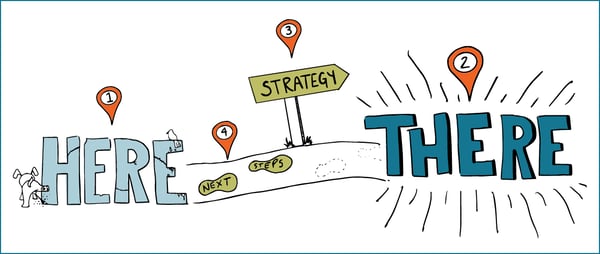
See what I mean? How hard can that be?
Yet, so often there can be confusion and debates on various terms and perspectives, including “What is Strategy Really?” explored by strategy guru Michael Porter back in 1996 (still a seminal piece) and many others since. If we can’t even agree on what it is, it’s no wonder it is hard to put into practice.
A search on Harvard Business Review will serve up articles with various titles that reinforce this first fundamental truth of strategic leadership – strategy is easy in principle, hard in practice:
- “Don’t Mistake Execution For Strategy”
- “Many Strategies Fail Because They’re Not Actually Strategies”
- “Don’t Let Strategy Become Planning”
I think the hardest part of strategy is that we describe it as this simple linear process and pathway when it is creative, non‑linear, and operating in an ever‑changing environment. Much of what makes it so hard in practice, is the second fundamental truth of strategic leadership.
Leadership Strand: ‘These Darn People’ Get in the Way of Great Strategy Becoming Reality
After decades of crafting business strategies in larger organizations (on the scale of x,000s to xx,000s employees), the one thing I found that consistently got in the way of great strategic impact were ‘these darn people’. Including myself.
Strategic leadership requires us to get comfortable with being uncomfortable.
And to build capacity and resilience to navigate the:
- VUCA (Volatility, Uncertainty, Complexity, and Ambiguity) inherent in strategy
- Critics, Doubters and Dis‑believers (yours and others)
- Consequence of our beliefs
Let’s take a deeper look at this.
A. VUCA Challenge = Risk of Incompetence – “I don’t know”
The most impactful strategic leaders see what other people don’t see yet. As William Gibson said, “The future is already here, it’s just not evenly distributed”.
When you are leading strategically you will be taking the road less traveled. It is in those moments of uncertainty, when you take the leap of courage to stand in your beliefs, that there is opportunity to create tremendous long‑term value. And equally a tremendous amount of risk. No one can truly know the future. What if you are wrong? Will you risk your credibility?
In the face of uncertainty there are only two choices. Focus your attention on the possibility or the risk. It is like driving down a foggy road when you can’t see more than two feet in front of you. You don’t know the roads and you can’t see where they will take you. But you believe. You trust in your direction, the next two feet of road, and your ability to course correct.
B. Critics Challenge = Risk of Rejection
And if your own doubts aren’t enough, there will always be a group of people that will question you, challenge you, and won’t believe in your vision and recommendations. At times that group will be the people closest to you. You might feel betrayed by them. Why won’t they just give you the benefit of doubt? Trust you? Believe in you? How will you react or respond?
C. Consequence of Belief Challenge = Risk of Failure
This is strategy in action and where I see it come off the rails most. The risk of incompetence compounds with the risk of failure which compounds with the risk of rejection. It is here that we must have the courage of our convictions. To lean into the risk of failure and admit when we are wrong.
Howard Shultz starts with an admission of guilt. Accepting responsibility for what is, even when we don’t want to face it. “We got this wrong”, he says. And then stands for his beliefs, even when it was guaranteed to run the team right into the judgment of others. Investors. Competitors. Will you take the risk? And the responsibility?
Our Habits
In my experience, we fall on a continuum in how we lead through these challenges and foundational threats to our biology: with great conviction or great connection. We have habitual ways of reacting. They can vary by situation. For many of us, it is not fully conscious. Each has benefits. Each has costs.
Leading with Conviction
Some leaders have strong convictions about the future direction of their organizations. They don’t lack clarity or certainty. They struggle to drive alignment, engagement, and commitment to their vision. Their challenge is getting those “darn people” to turn their strategy into reality. The power of hierarchy can drive compliance, but not commitment. And in matrix organizations, alignment is essential.
Leading with Connection
Other leaders are very receptive and inclusive of different ideas and perspectives. They are collaborative and approachable. They struggle to step out on a limb and stand for a bold and distinct future that they believe in, especially in the face of challenge or resistance. Their big ideas become more incremental as they try to avoid conflict and sustain team harmony.
Despite all our capabilities and accomplishments, we still can be reduced to this simple choice ‑ whether we realize it or not. Belong OR stand out.
What if we could gain the benefits and reduce the costs of each approach? What if we could Belong AND Stand‑out? This is the essence of strategy. To stand out from the competition in ways our ideal customers value.
The Possibility of Game-Changing Strategic Leadership: Leading With Conviction AND Connection
The most impactful strategic leaders strike a balance: maintaining strong conviction for a strategic vision that is shaped and co‑created through connection, receptivity, and inclusion of the ideas, perspectives, and contributions of others.
Strategic leaders recognize that they can’t see or know everything, especially in a world of ever‑increasing complexity and volatility.
- They challenge the status quo, envision a future that few can see AND they seek different points of view, and welcome challenges in support of creating new realities.
- They can be influenced as much as they seek to influence.
- They know how to pivot from the creative phase to the decisive phase of strategy — making the tough decisions and being relentless in their clarity of focus and priority.
- They walk the fine line between decisive and inclusive to execute bold, disruptive strategies with a high level of alignment, commitment, and engagement.
These are game‑changing leaders creating game‑changing strategies.
Key Behaviors of Game‑Changing Strategic Leaders
These game‑changing leaders comfortably balance the many dualities of leadership:
- decisive and inclusive
- creative and productive
- vision and results
- purpose and profit
- change and stewardship
In their presence, people feel heard, even if not agreed with. They are human, so they make mistakes, and get caught in their fears, egos, and defensive reactions — but this is the exception, not the norm.
Even more importantly, they are committed to learning from their mistakes instead of hiding from them, or worse yet blaming others. They are self‑aware and committed to becoming even more so each day. They care about their impact on others and readily lean into the discomfort of growth, both personally and for the broader organization. They lead not by fear but inspiration.
Strategic Leadership Role Models
I have lived and learned through my own leadership journey how hard it is to consistently show up as this type of game‑changing leader. Researchers estimate this type of transformational leadership requires a level of development only achieved by about 5% of the population.
We see it in leaders like
- Herb Kelleher (Southwest)
- Indra Nooyi (Pepsi)
- Alan Jope (Unilever)
These leaders show us that it is possible to have bold, decisive leaders without rampant egoism or heroism. They show us that we no longer need to accept the collateral damage of our current model of disruptors, like early Steve Jobs.
I am working to create a world where this type of game‑changing leader is more common. A world where distinct strategies and distinctive leadership go hand in hand. Whether still with us or, in the case of Herb Kelleher, in memory, these leaders show us that corporations can be a force of change for good, when we each commit to our ongoing development — as leaders, as humans.
The Pathway to Game-Changing Strategic Leadership
My vision is grand AND possible through dedicated practice.
We are what we practice each day. I set a daily intention to lead just 2% more like my vision of these game‑changing leaders. Some days I am more successful, some less. The result on any one day is less important than the consistency of the practice.
This is similar to my yoga practice. It is neither grand nor long (rarely more than 20 minutes). Some days I make it to the mat. Some days I don’t. And despite what my judgmental‑self labels as ‘feeble practice,’ the shift in my strength, balance, and flexibility over these last few years continues to surprise me.
The DNA strands of strategic leadership will be present and intertwined throughout the journey. They are inextricably linked, as how you lead (leadership behaviors and mindsets) will invariably influence where you lead. At any moment, we can choose to amplify our strategic impact through deeper insight and the courage of our convictions and connections.
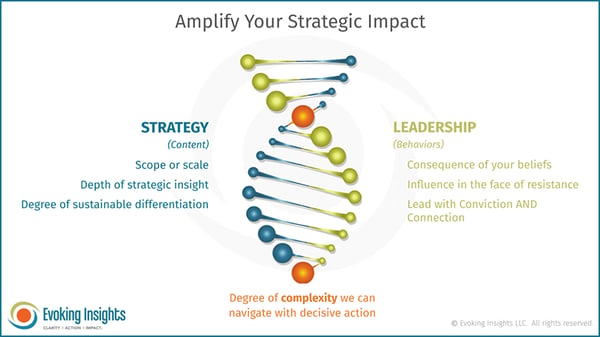
The journey will be different and distinct for each of us.
We all start with different strengths, talents, and experiences. And it is not linear, as much as our desire for control and certainty might want it to be. Ironically, the greater the strategic impact, the more we must embrace what we cannot control. You may find the strategy strand of your Strategic Leadership DNA leads or lags relative to your leadership strand of DNA. You may also start to notice that your stage of development in one impedes the other.
While I am blessed with a natural gift around strategic thinking, I still aspire to have the courage of conviction to take a bold stand in the face of tremendous criticism and still lead in a way consistent with my values. Howard Shultz’s example remains an aspirational possibility for me.
At any moment, we might bump into an edge of discomfort that we just can’t quite tolerate yet. That we avoid. Or that causes us to fall into those habitual ways of leading that we don’t like, others don’t like and that just aren’t quite as effective as they could be.
My hope is to orient you to that edge, wherever it may be, and inspire you to lean into and expand beyond it. Because when you can see it, you can make intentional choices to practice something different. Something that helps you, each day, be just 2% more of that trailblazer that you are called to be.
Stages of the Strategic Leadership Journey
These are the four stages of the journey.
Stage 1: Thinker
The biggest shift in this initial stage of strategic leadership is from a sole focus on near‑term results to longer‑term horizons and positioning. From the urgent to the important. And then, your attention will expand from how to accomplish a near‑term goal to considering whether it should be a goal at all, relative to where the organization is headed.
A key shift is in the time you spend thinking about the broader environment in which you operate (internal and external) and strengthening the strategic logic and context considered in your recommendations. Your sense of value as a leader will move from delivering near‑term results to setting longer‑term direction. It’s shifting from harvesting a garden to planting the seeds for future gardens.
Strategy Strand
In this early phase of strategic leadership, you will likely demonstrate your skills in the context of recommended strategic initiatives versus a comprehensive strategic plan for a business or function. Ideas often are more in the realm of the known and familiar at this stage. Like implementing best practices.
Experiment with those key strategy behaviors to deepen your strategic thinking and strengthen the strategic logic of your recommendations. Carve out time in your schedule to pull‑back from the day‑to‑day, expand your perspective and think broadly about the issue or opportunity before you. Consider alternative options to achieve the same objective and what might make your recommended set of trade‑offs the right ones for your business and context.
Leadership Strand
Start by cultivating a strategic mindset that you can apply to your ideas, recommendations, and even how you contribute to meetings. Notice if you focus more on how to accomplish a stated goal and the tangible next steps of implementation. Shift your perspective to consider the broader purpose or objective and why it is important now. The mindset at this stage has more certainty to it, a belief that the past predicts the future. The world is knowable, with the right level of expertise. Appetite for risk is either low or ungrounded.
Stage 2: Planner
The Planner’s strategic scope and complexity expands to creating a long‑range strategic plan for their business or function. A sense of direction is created in the form of focus and priorities. Habitual ways of reacting to the increasing degrees of complexity, uncertainty, and challenge are the norm – leading with great Conviction OR Connection.
Strategy Strand
The Planner carves out significant time, often in the context of a strategic planning process, offsite, or workshop to outline focus and priorities in the coming year. In larger organizations, templates may be provided that help you outline key considerations – including key initiatives, investments, and expected results. This phase can feel like painting by numbers – templates and frameworks bring a sense of confidence and certainty that you will produce the desired result. The key elements are already present.
The plan will provide clarity of focus, although strategy statements and visions may feel more familiar. And while the elements of market analysis and consideration are present, the depth of strategic insight may be lighter.
Leadership Strand
The strategic decisions of a Planner tend to optimize for predictability, still acting as if the world is knowable and controllable. Instead of embracing VUCA, you are most likely avoiding it, simplifying it, and/or trying to control it. You may try to analyze your way into the future and treat strategy as a solvable problem with tried and tested tools and techniques.
Replicating the choices that appear to be succeeding for others, as a “fast follower”, is more common than setting out in a bold and uncertain direction. Or your bold direction isn’t sufficiently grounded in your context. You lack the credibility to influence and align people to that bolder direction and you personalize any resistance to your vision.
Stage 3: Creator
Your strategic leadership is now occurring in the day‑to‑day, constantly aligning short‑term actions across the organization with long‑term direction. Strategy and plan are no longer synonymous, and you are building the capacity to navigate greater uncertainty and complexity. You accept that the future isn’t knowable or controllable. Your strategy is unique and distinct as you begin to challenge paradigms, rethink opportunities, and change the rules of the game. You are building capacity to lead with Conviction AND Connection.
Strategy Strand
You understand simply following competitors’ choices will never produce a unique advantage. Your energy and attention are focused on the key choices that influence revenue decision‑makers— i.e. your customers, who only decide to spend their money with your company if your value proposition meets their needs and is superior to competitors’.
The robustness of your strategic thinking and the depth of insight that drives your choices is increasing. The assumptions and logic that drive your strategic bets are well documented, tested, and continually revisited to make necessary adjustments.
Leadership Strand
You are now making angst‑ridden decisions about unknowable and uncontrollable things and saying no to compelling opportunities that others choose to pursue. You accept that the future isn’t predictable and make hard choices anyway. Decisive, despite VUCA (volatility, uncertainty, change, ambiguity). You accept that strategy involves a bet and that your job is to increase the odds of success, not eliminate all risk.
Here, your position is further out ‘on the limb’ and you are building the capacity to manage the discomfort that comes with the rising risks of incompetence, rejection, and failure. Ugh. It is hard work. But you are building the capacity to have these emotions and still be at choice with how you lead. You can see your habitual way of leading — with Conviction OR Connection — and you begin practicing both ‘AND’. You stretch yourself to either be bolder and more assertive, or less certain and more receptive. Your influence increases and you’re able to navigate through greater degrees of change resistance.
Stage 4: Transformer
This stage is an extension of the Creator. The primary difference lies in the scope, scale and consequence of your leadership. The degree of risk, the level of complexity, the depth of strategic insight, the courage of conviction ‑ all continue to rise.
It is at this stage we begin to approach the conviction and consequence of our beliefs on the level of Howard Schultz and Herb Kelleher. It’s when we remain resilient and resourceful in the face of obstacles like these:
- “It cost us millions of dollars.”
- “I came under tremendous criticism.”
- “Competition smelled blood and went after us.”
We are able to have the conviction of our beliefs AND remain as inclusive as we are decisive.
Strategy Strand
At this stage, defying conventional wisdom is the norm. You continue to make tougher and tougher calls. The type that when someone says, “so that means we won’t do x” and as you say “that is right” your heart drops, you get a pit in your stomach and you take a deep breath and hope it is the right call. You accept that if you are entirely comfortable with your strategy, there is a strong chance it isn’t that good.
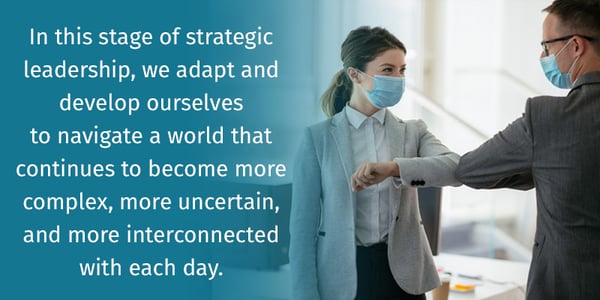
Leadership Strand
Like the Creator, you are willing to explicitly cut‑off possibilities and options and you accept the discomfort of leading outside your comfort zone. You are maniacally focused on your strategic choice and act with great strategic consistency in the day‑to‑day.
In this stage, our capacity builds to reach beyond our protective habits in the face of fear and uncertainty ‑ to control, simplify, be certain or safe within the known and familiar ‑ and make different choices. We are learning to surrender to what we cannot control and create from what emerges.
Colleagues praise me for my ability to influence at the most senior levels of an organization. And yet, I still couldn’t navigate the level of resistance faced by Martin Luther King or Nelson Mandela. I am still building my capacity to navigate the risks of incompetence, rejection and failure without being hijacked by my ego and biology. But I am committed to the practice.
In this stage of strategic leadership, we adapt and develop ourselves to navigate a world that continues to become more complex, more uncertain, and more interconnected with each day. We reject simplistic reactions and tap into a truer, fuller, more capable version of ourselves that can solve some of the most complex challenges in the world.
The Call to Strategic Leadership
And so here we are. Strategic leaders. Sitting in complexity that can be overwhelming. Getting comfortable with being uncomfortable. Embracing the uncertainty and developing in ways that enable us to transform the world, through business, for good. On whatever scale is possible, today. And a different scale that becomes possible tomorrow.
Remember, the scale isn’t the defining element of being the game‑changer that you are. Only the possibility.
So, what is sitting right at the edge of possibility for you today? What different choice do you want to make?
